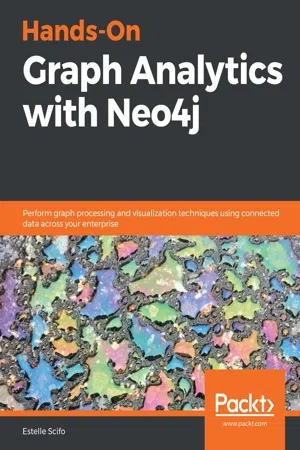
Hands-On Graph Analytics with Neo4j
Perform graph processing and visualization techniques using connected data across your enterprise
- 510 pages
- English
- ePUB (mobile friendly)
- Available on iOS & Android
Hands-On Graph Analytics with Neo4j
Perform graph processing and visualization techniques using connected data across your enterprise
About this book
Discover how to use Neo4j to identify relationships within complex and large graph datasets using graph modeling, graph algorithms, and machine learning
Key Features
- Get up and running with graph analytics with the help of real-world examples
- Explore various use cases such as fraud detection, graph-based search, and recommendation systems
- Get to grips with the Graph Data Science library with the help of examples, and use Neo4j in the cloud for effective application scaling
Book Description
Neo4j is a graph database that includes plugins to run complex graph algorithms.
The book starts with an introduction to the basics of graph analytics, the Cypher query language, and graph architecture components, and helps you to understand why enterprises have started to adopt graph analytics within their organizations. You'll find out how to implement Neo4j algorithms and techniques and explore various graph analytics methods to reveal complex relationships in your data. You'll be able to implement graph analytics catering to different domains such as fraud detection, graph-based search, recommendation systems, social networking, and data management. You'll also learn how to store data in graph databases and extract valuable insights from it. As you become well-versed with the techniques, you'll discover graph machine learning in order to address simple to complex challenges using Neo4j. You will also understand how to use graph data in a machine learning model in order to make predictions based on your data. Finally, you'll get to grips with structuring a web application for production using Neo4j.
By the end of this book, you'll not only be able to harness the power of graphs to handle a broad range of problem areas, but you'll also have learned how to use Neo4j efficiently to identify complex relationships in your data.
What you will learn
- Become well-versed with Neo4j graph database building blocks, nodes, and relationships
- Discover how to create, update, and delete nodes and relationships using Cypher querying
- Use graphs to improve web search and recommendations
- Understand graph algorithms such as pathfinding, spatial search, centrality, and community detection
- Find out different steps to integrate graphs in a normal machine learning pipeline
- Formulate a link prediction problem in the context of machine learning
- Implement graph embedding algorithms such as DeepWalk, and use them in Neo4j graphs
Who this book is for
This book is for data analysts, business analysts, graph analysts, and database developers looking to store and process graph data to reveal key data insights. This book will also appeal to data scientists who want to build intelligent graph applications catering to different domains. Some experience with Neo4j is required.
Frequently asked questions
- Essential is ideal for learners and professionals who enjoy exploring a wide range of subjects. Access the Essential Library with 800,000+ trusted titles and best-sellers across business, personal growth, and the humanities. Includes unlimited reading time and Standard Read Aloud voice.
- Complete: Perfect for advanced learners and researchers needing full, unrestricted access. Unlock 1.4M+ books across hundreds of subjects, including academic and specialized titles. The Complete Plan also includes advanced features like Premium Read Aloud and Research Assistant.
Please note we cannot support devices running on iOS 13 and Android 7 or earlier. Learn more about using the app.
Information
- Chapter 1, Graph Databases
- Chapter 2, The Cypher Query Language
- Chapter 3, Empowering Your Business with Pure Cypher
- Graph definition and examples
- Moving from SQL to graph databases
- Neo4j: the nodes, relationships, and properties model
- Understanding graph properties
- Considerations for graph modeling in Neo4j
Graph definition and examples
Graph theory
A bit of history: the Seven Bridges of Königsberg problem

A: 3 connections (to C twice, and to D once)
B: 3 connections (to C twice, and to D once)
C: 5 connections (to A twice, to B twice and to D once)
D: 3 connections (to A once, to C once and to D once)
Graph definition
- V, a set of nodes or vertices: the islands in our previous example
- E, a set of edges connecting nodes: the bridges
V = [A, B, C, D]
E = [
(A, C),
(A, C),
(C, B),
(C, B),
(A, D),
(C, D),
(B, D)
]
Visualization

Examples of graphs
Networks
Table of contents
- Title Page
- Copyright and Credits
- About Packt
- Contributors
- Preface
- Section 1: Graph Modeling with Neo4j
- Graph Databases
- The Cypher Query Language
- Empowering Your Business with Pure Cypher
- Section 2: Graph Algorithms
- The Graph Data Science Library and Path Finding
- Spatial Data
- Node Importance
- Community Detection and Similarity Measures
- Section 3: Machine Learning on Graphs
- Using Graph-based Features in Machine Learning
- Predicting Relationships
- Graph Embedding - from Graphs to Matrices
- Section 4: Neo4j for Production
- Using Neo4j in Your Web Application
- Neo4j at Scale
- Other Books You May Enjoy